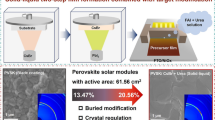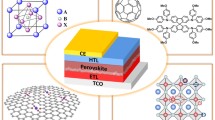Abstract
Thermal stability is inevitable for upscaling and commercialization of third-generation photovoltaic devices. Heat generation in solar cells directly impacts their thermal stability. One of the rarely investigated heat-generation sources is tunneling recombination. Here, the heat generation via trap-assisted tunneling recombination (TATR) has been investigated for Cu2ZnSn(S,Se)2 or CZTSSe Kesterite thin-film solar cells using a coupled formulation and a simulation model developed by coupling the optical–electrical–thermal modules in the COMSOL simulation package. Heat generation from tunneling recombination was compared to heat from non-radiative Shockley–Read–Hall (SRH) recombination. All the simulations were performed for the three defects in the bulk of the CZTSSe and CdS layers: CuSn (0.55 eV), CuZn (0.1 eV), and SnZn (0.87 eV), which were chosen from the experimental data reported in the literature. Dark current density versus voltage and defect density were calculated and resulted in a higher tunneling recombination compared to the SRH recombination. The dark current density was also analyzed for a range of defect densities in the CdS partner layer, and for different recombination lifetimes, which resulted in a stronger dark current from TATR compared to SRH. Dark current in all the above analyses was obtained to be highest for CuSn. Finally, the heat-generation rate from the tunneling recombination was simulated versus voltage and cell thickness, and resulted in higher heat generation for the tunneling recombination, especially for the CuSn defect. This means that the contribution of the tunneling recombination to heat generation in thin-film solar cells is stronger than the non-radiative SRH recombination or interface recombination and could be a dominant thermal degradation mechanism in these cells, a finding that has often been neglected in the literature.





Similar content being viewed by others
Availability of Data and Materials
Data sharing not applicable to this article as no datasets were generated or analyzed during the current study. no confidential and non-IP Materials and data will be available upon request.
References
S. Zeiske, O.J. Sandberg, N. Zarrabi, W. Li, P. Meredith, and A. Armin, Direct observation of trap-assisted recombination in organic photovoltaic devices. Nat. Commun. 12, 3603 (2021).
A.W. Walker, O. Theriault, M.M. Wilkins, J.F. Wheeldon, and K. Hinzer, Tunnel-junction multijunction solar cell performance over concentration. IEEE J. Sel. Top. Quantum Electron. 19, 4000508 (2013).
M. Baudrit and C. Algora, Tunnel diode modeling, including nonlocal trap-assisted tunneling: a focus on III–V multijunction solar cell simulation. IEEE Trans. Electron Devices 57, 2564 (2010).
S. Lee, J. Park, S. Kim, Y. Kim, Ch. Jeong, and J. Yi, The effect of double doped nc-Si: H tunnel recombination junction in a-Si:H/c-Si tandem solar cells. Semicond. Sci. Technol. 33, 075017 (2018).
A. Sáez Armenteros, Trap assisted tunneling modelling for aSi contact stacks in IBC-SHJ, MSc Thesis for Sustainable Energy Technology, Delft University of Technology, (2021).
M. Vukadinović, F. Smole, and M. Topič, Transport in tunneling recombination junctions: a combined computer simulation study. J. Appl. Phys. 96, 7289–7299 (2004).
A.C. Espenlaub, D.J. Myers, E.C. Young, S. Marcinkevičius, C. Weisbuch, and J.S. Speck, Evidence of trap-assisted Auger recombination in low radiative efficiency MBE-grown III-nitride LEDs. J. Appl. Phys. 126, 184502 (2019).
J. Furlan, Z. Gorup, F. Smole, and M. Topič, Modeling tunneling assisted generation and recombination rate in space charge region of PN aSi: H Junction. J. Model. Simul. Microsyst. 1, 109–114 (1999).
M. Hermle, G. Letay, S.P. Philipps, and A.W. Bett, Numerical simulation of tunnel diodes for multi-junction solar cells. Prog. Photovolt: Res. Appl. 16, 409–418 (2008).
Q. Bao, O. Sandberg, D. Dagnelund, S. Sanden, S. Braun, H. Aarnio, X. Liu, W. Chen, R. Osterbacka, M. Fahlman, Trap-Assisted Recombination via Integer Charge Transfer States in Organic Bulk Heterojunction Photovoltaics, PhD thesis at Linköping University (2014).
R.A. Vijayan, S. Essig, S. De Wolf, B.G. Ramanathan, Ph. Loper, and M. Varadhara, Hole-collection mechanism in passivating metal-oxide contacts on si solar cells: insights from numerical simulations. IEEE J. Photovoltaics 8, 473–482 (2018).
M. Mohammed, Quantum-mechanical modeling towards trap-assisted tunneling in semiconductor devices, PhD thesis, KU-Leuven, (2018).
S. Kim, J.S. Park, and A. Walsh, Identification of killer defects in Kesterite thin-film solar cells. ACS Energy Lett. 3(2), 496–500 (2018).
M. Courel, J. Arvizu, and O. Galán, The role of buffer Kesterite interface recombination and minority carrier lifetime on kesterite thin film solar cells. Mater. Res. Express 3, 095501 (2016).
M. Courel, A. Arvizu, and O.V. Galán, Loss mechanisms influence on Cu2ZnSnS4/CdS based thin film solar cell performance. Solid-State Electron. 111, 243–250 (2015).
M. Courel, A. Arvizu, and O.V. Galán, Towards a CdS/Cu2ZnSnS4 solar cell efficiency improvement: a theoretical approach. Appl. Phys. Lett. 105, 233501 (2014).
L. Sravani, S. Routray, M. Courel, and K. Pradhan, Loss mechanisms in CZTS and CZTSe Kesterite thin-film solar cells: understanding the complexity of defect density. Sol. Energy 227, 56–66 (2021).
M. Courel, E. Valencia-Resendiz, J. Andrade-Arvizu, E. Saucedo, and O. Vigil-Galán, Towards understanding poor performances in spray-deposited Cu2ZnSnS4 thin film solar cells. Sol. Energy Mater. Sol. Cells 159, 151–158 (2017).
M. Rahaman, A. Chowdhury, M. Islam, M. Rahman, CZTS based thin film solar cell: an investigation into the influence of dark current on cell performance, in 2nd International Conference on Imaging, Vision Pattern Recognition, 18469480, (2018).
M. Courel, F.A. Pulgarin, J. Andrade-Arvizu, and O. Vigil-Galán, Open-circuit voltage enhancement in CdS/Cu2ZnSnSe4-based thin film solar cells: A metal-insulator-semiconductor (MIS) performance. Sol. Energy Mater. Sol. Cells 149, 204–212 (2016).
S. Zandi, M.J. Seresht, A. Khan, and N.E. Gorji, Simulation of heat loss in Cu2ZnSn4SxSe4-x thin film solar cells: A coupled optical-electrical-thermal modeling. Renewable Energy 181, 320–328 (2022).
Y. An, Ch. Sheng, and X. Li, Radiative cooling of solar cells: opto-electro-thermal physics and modeling. Nanoscale 11, 17073–17083 (2019).
W. Wang, M.T. Winkler, O. Gunawan, T. Gokmen, T.K. Todorov, Y. Zhu, and D.B. Mitzi, Adv. Energy Mater. 4(7), 1–5 (2013).
M. Courel, T. Jimenez, M. de los Santos, J.P. Morán Lázaro, M. Ojeda-Martinez, L.M. Pérez, D. Laroze, E. Feddi, and F.J. Sánchez-Rodríguez, Impact of loss mechanisms through defects on Sb2(S1-xSex)3/CdS solar cells with p-n structure. Eur. Phys. J. Plus 137(3), 396 (2022).
M.M. Makhlouf, and M.M. Shehata, Multilayer emitter of molybdenum oxide/silver/molybdenum oxide thin films for silicon heterojunction solar cells: Device fabrication and electrical characterization. J. Alloy. Compd. 904, 164102 (2022).
V. Dao, Th. Trinh, S. Kim et al., Carrier transport mechanisms of reactively direct current magnetron sputtered tungsten oxide/n-type crystalline silicon heterojunction. J. Power Sources 472, 228460 (2020).
G.A.M. Hurkx, H.C. de Graaff, W.J. Kloosterman, and M.P.G. Knuvers, IEEE Trans. Electron. Dev. 39(9), 2090–2098 (1992).
A. Hajjiah, COMSOL simulation of non-radiative recombination heat and joule heat in CZTSSe thin film solar cells. Micro and Nanostructures 168, 207313 (2022).
A. Shang, and X. Li, Photovoltaic devices: opto-electro-thermal physics and modeling. Adv. Mater. 2(8), 1603492 (2017).
Y. An, A. Shang, G. Cao, Sh. Wu, D. Ma, and X. Li, Perovskite solar cells: optoelectronic simulation and optimization. Sol. RRL 2(11), 1800126 (2018).
Available at: https://www.comsol.fr/blogs/simulating-the-tunneling-current-across-a-graded-heterojunction/.
B. Shin, O. Gunawan, Y.U. Zhu, N.A. Bojarczuk, S.J. Chey, and S. Guha, Thin film solar cell with 8.4% power conversion efficiency using an earth abundant Cu2ZnSnS4 absorber: Cu2ZnSnS4 solar cell with 8.4% efficiency. Prog. Photovolt. Res. Appl. 21(1), 72–76 (2013).
A. Haddout, M. Fahoume, A. Qachaou, A. Raidou, and M. Lharch, Understanding effects of defects in bulk Cu2ZnSnS4 absorber layer of kesterite solar cells. Sol. Energy 211, 301–311 (2020).
Ch. Messmer, M. Bivour, J. Schon, S.W. Glunz, and M. Hermle, Numerical simulation of silicon heterojunction solar cells featuring metal oxides as carrier. IEEE J. of Photovolt. 8(2), 456–464 (2018).
A.L. Danilyuk, T.N. Sidorova, V.E. Borisenko, H. Wang, R. Rusli, and Ch. Lu, An enhanced charge carrier separation in a heterojunction solar cell with a metal oxide. Phys. Status Solidi A 219, 2100525 (2022).
Acknowledgments
Not Applicable.
Funding
This work was not supported with any specific funding.
Author information
Authors and Affiliations
Contributions
AH performed the simulations, validation of results, conceptualization, and manuscript preparation. AH performed simulations.
Corresponding author
Ethics declarations
Conflict of interest
On behalf of all authors, the corresponding author states that there is no conflict of interest.
Additional information
Publisher's Note
Springer Nature remains neutral with regard to jurisdictional claims in published maps and institutional affiliations.
Rights and permissions
Springer Nature or its licensor (e.g. a society or other partner) holds exclusive rights to this article under a publishing agreement with the author(s) or other rightsholder(s); author self-archiving of the accepted manuscript version of this article is solely governed by the terms of such publishing agreement and applicable law.
About this article
Cite this article
Hajjiah, A., Hajiah, A. Study of Heat Generation via Trap-Assisted Tunneling Recombination in Cu2ZnSn(S,Se)2 Thin-Film Solar Cells. J. Electron. Mater. 52, 5987–5995 (2023). https://doi.org/10.1007/s11664-023-10540-5
Received:
Accepted:
Published:
Issue Date:
DOI: https://doi.org/10.1007/s11664-023-10540-5




